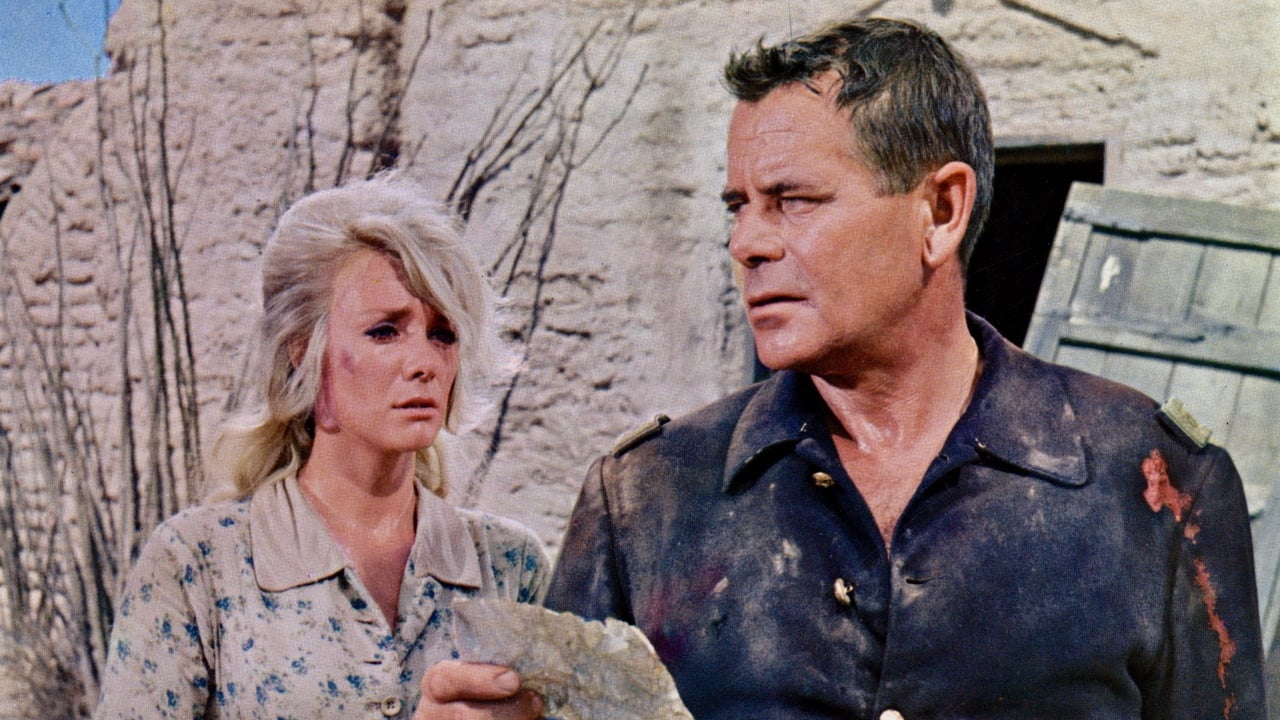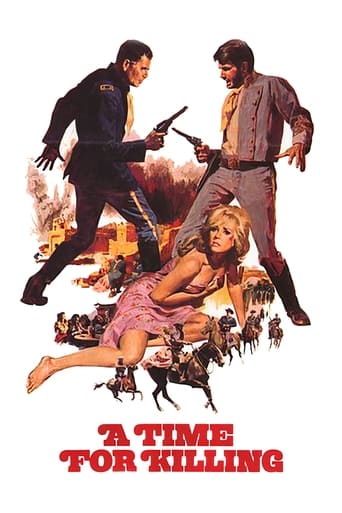Interesteg
What makes it different from others?
StunnaKrypto
Self-important, over-dramatic, uninspired.
ChicRawIdol
A brilliant film that helped define a genre
Skyler
Great movie. Not sure what people expected but I found it highly entertaining.
jjnxn-1
Somewhat scattered drama set in the last days of the Civil War. Glenn Ford is the top billed star but he disappears for almost the entire middle of the film and it's really George Hamilton and Inger's show. Partly a chase story and partly a drama of how once fastidious men can be corrupted and destroyed by war. George does fine as the Confederate soldier who can't face the war's imminent end since it has given him purpose and he has nothing to go back to. This was made towards the end of his short serious actor phase before he slipped into the overly tanned caricature he became and he gives it his best effort.Inger Stevens, breathtakingly beautiful in the first of several westerns she made in the period between the end of her series "The Farmer's Daughter" and her too early death, registers strongly as the missionary who is in love with Glenn Ford but must contend with her captive status against George and his increasingly unruly band of refugees. It also affords a chance to see several notable actors starting out. Max Baer of Beverly Hillbillies Jethro fame plays a total whack job with brio and Harry Dean Stanton shows up in a small part. Most surprisingly right at the top of the film is a baby faced Harrison Ford who vanishes after a few minutes. Not really a western nor a great film by any means but a decent effort if you like dramas set in the West.
clore_2
It aired on TCM last night and as I remembered that when it came out in 1967 I walked out of it, I wanted to see just how bad this thing was, or if I was that impatient. I rarely walk out on films.As soon as the credits ended, I was reminded of one of the initial negative reactions I had to the film. We get a title song under the credits (left over from when the production title was "The Long Ride Home") and as soon as the director credit disappears, so does the song. As in someone picked the needle up off the phonograph record before it was done. That's only the first example of the kitchen blender editing that goes on in this film.A group of Confederates are in a Northern fort, caged in a big pen and apparently treated decently by Major Glenn Ford. The leader of this group is played by George Hamilton and when his accent isn't atrocious, it's gone. The editing faults show up again when somehow a bunch of the rebels kill some guards, turn the fort's cannons around and begin firing on it. We just don't get to see how they managed to get out of the holding pen in which they were confinedThey escape through some magical tunnel that leads to the river, but with no establishing shots, we have no idea of how far that tunnel goes. We never even get a shot in the tunnel. The rebs manage to catch up to and defeat a previously departed detail that includes Ford's betrothed Inger Stevens and they accomplish this by magically hiding in trees that manage to be right in the path of each Union soldier in the detail as they attempted to scatter when fired upon.There's all sorts of exposition here to show us what a mean bastard Hamilton is - he's left most of his men behind when he should have waited for them at the river. There's so much exposition that we forget that top-billed Glenn Ford is even in the film since he disappears for about a half-hour. Ford's search party includes two comic relief types (one of whom is Dick Miller) who seem to have walked in from another movie or an episode of "F Troop." This is made more apparent as they are frequently seen in obvious studio shots that don't match the surrounding footage shot on location.It was at this point that I recalled that this film was started by Roger Corman but it was usurped by the studio and given to Phil Karlson. Corman's involvement would explain Dick Miller, but the handling of his scenes might explain why Corman was dismissed. Apparently it was enough of a disaster for longtime producer Harry Joe Brown to quit the business.Harrison Ford (billed with middle initial "J") gets reasonably prominent billing but he disappears once the film leaves the fort - we don't see if he's killed while the rebels escape. Paul Petersen is given very prominent billing above the title, but he doesn't show up with any dialogue until Glenn Ford comes back into the film in the last half-hour. That's just as well, Petersen is horrendous in his few scenes.Even worse is Max Baer, Jr. as a whacked-out Confederate who loves killing and physically sparring with a buddy. This goes on my list of all-time worst performances and it indicates why Baer never got beyond Jethro Bodine on "The Beverly Hillbillies." Surprisingly effective is Todd Armstrong as Hamilton's sympathetic second-in-command yet this was his last feature film. As George Hamilton's moral conscience, he has the most well-written role in the film.There is one strong plot twist here involving Inger Stevens that is quickly thrown away. En route, Baer comes across a Union dispatch carrier and kills him, taking from him the message that the war is over. The message couldn't have been that important to the carrier anyway as he's hanging out in a cantina with a bunch of whores. Hamilton swears Baer to silence (this way he "can kill more blue-bellies") as he wants to engage in a cat-and-mouse game with Ford.This makes no sense as there would be no need for further pursuit but that would mean that the film would end just as abruptly as the title song. So just in case, Hamilton rapes and beats Stevens after telling her that the war is over. He leaves her there, but when Ford (the Glenn one, not Harrison) catches up to her, she fails to tell him that the war is over. She wants vengeance for having been spoiled. The film makes little more of that motive.I could go on, but the film isn't really worth the verbiage I've given it thus far. Consider this a public service message and beware at all costs.
Robert J. Maxwell
In 1865, somewhere out West, around Las Cruces, a band of Confederate prisoners led by George Hamilton escape from a Yankee fort with missionary Inger Stevens as hostage. They head for the safety of Mexico. They are pursued by a unit of Federal soldiers led by Major Glenn Ford. By the time the end rolls around, all the men of both sides have either been killed or have run away except for Hamilton and Ford, who shoot it out over the outraged honor of Inger Stevens.Now, there's a certain dramatic potential in a story like this, and the director, Phil Karlson, who has done some brutal work elsewhere, starts it off well. In the opening scene, a rebel prisoner has killed a guard while trying to get out and he is about to be shot by a firing squad. But the end of the war is near. Everyone knows it. And the squad balks. So the Commanding Officer turns the rifles over to the Colored Troops, as they were called, and orders them to fire at the prisoner. The nervous squad of ex-slaves has never handled rifles before and mostly they miss. The wounded prisoner cries out, "I'm still alive." They reload and fire. Once again they only wound the tortured man, who screams and laughs. The scene is excruciating.From there on, it's pretty much downhill. The usual problem is that cliché is piled upon cliché. Here, it's that the narrative itself falls apart, not so much because the conventions are too strictly observed but because the writers seemed to be seated on a runaway wagon.That Southern Captain -- Hamilton -- is a proud man and a determined one. "This war will never end," he mutters several times, a gentleman warrior. Yet, when he's alone with Inger Stevens, he slaps her around, rips her dress off, runs his spur along her naked flesh, and savagely rapes her. Whose breath blew out the light within this brain? But then nobody's motivations are entirely clear. They aren't ambiguous, as they are for you and me. They're muddled and conflicting and almost drawn up in order to suit the demands of the situation. Example: Glenn Ford is leading the pursuit but he's firm in his decision to not chase them beyond the Mexican border. Not even the pleas of the battered Inger Stevens, the now-debauched missionary and nurse, will sway him. Yet, later, when one of his men is killed, he abruptly changes his mind and charges towards the final confrontation. The dead man was not particularly important to Ford or to the plot. That is, he wasn't Ford's cousin or son or anything. So the newly formed engram is left unexplained.The movie is "routine" by default. It doesn't carry with it the burden of ordinary stereotypes. It opens up a whole new package of problems involving mediocrity.The period detail is carelessly handled. The mob of Confederate prisoners wears new boots. By the end, any attempt at realism is tossed out the window. The muzzle-loading rifles of the opening scene are soon replaced by single-shot breach-loading carbines. And in the last scene, Winchester repeating rifles are used. No one ever pauses to load -- regardless of the weapon.The musical score is by Mundell Lowe, a decent guitarist, but it's terrible. From the beginning, we're subject to the kind of theme song common to the period, with lyrics. "A man's gotta ride home. But home is nowhere...." Something like that. The rest of the score would have provided a typical and uninteresting background for a shot of cars whizzing back and forth across the George Washington Bridge.It's not worth going on about.
johnboy1
This has always been one of my favorite Civil War flicks, along with Shenandoah, and Journey To Shiloh. Very gritty, exciting movie! However, I would never buy it unless it's released in the "wide screen" format, since much of the movie is invisible, due to the unacceptable use "pan and scan". Here's my vote for a DVD Wide Screen release.

